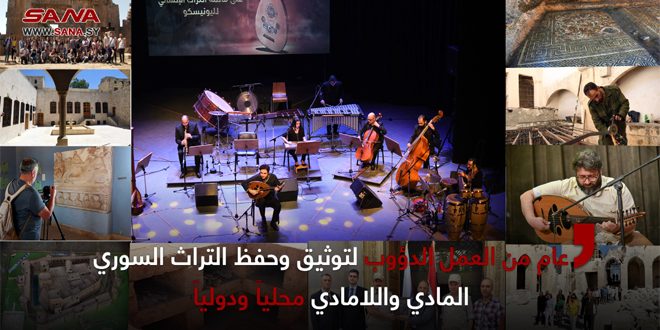Syria is home to a great mix of both tangible and intangible heritage which constitutes an important pillar within the World Heritage system , a key factor in strengthening the cultural identity of the Syrian people, in addition to building the present and protecting the future.
During the year 2022, the Ministry of Culture focused with its concerned institutions, specifically with the General Directorate of Antiquities and Museums ( GDAM) and the Directorate of Intangible Cultural Heritage, on organizing a number of events and symposiums and signing several agreements on the mechanisms of preserving this heritage.
Inscribing crafting and playing the oud on UNESCO’s List of Intangible Cultural Heritage culminated the ministry’s efforts exerted by the end of 2022.
The most important Syrian activities related to tangible and intangible heritage during the year 2022 were:
–Syria held several discussions about lending Syrian artifacts that were damaged during the terrorist war against Syria for restoration and display in Oman. It also signed a joint statement on cooperation in preserving cultural heritage with the People’s Republic of China.
– Syria participated in the International Forum for the Convention for the Protection of the World Cultural and Natural Heritage in the Russian city of Kazan, and the scientific conference on archeology in the Hungarian capital, and participated in a virtual lecture within a global conference on (protecting the Syrian cultural heritage after the war).
–Archaeological missions returned to excavations in 2022,including the joint Syrian-Italian archaeological mission, which began its work for the first stage at the archaeological site of Amrit.
–The national expertise of the GDAM worked to expand the work to discover the entire rare archaeological mosaic painting in the city of Rastan, which dates back to the Roman era.
–The completion of the restoration work of the Triumphal Arch in the ancient city of Palmyra, which was destroyed by terrorist organizations in 2015.
– Holding a workshop on “Restoring Syrian Heritage and Reviving Local Communities” at Expo 2020 Dubai, in which local, Arab and international bodies specializing in antiquities participated.
–At the National Museum in Damascus, and in honor of the spirits and sacrifices of nearly 27 martyrs who died during the terrorist war on Syria in defense of the Syrian cultural heritage, an exhibition on recovered archaeological treasures was held under the title “ A Tribute to the martyrs of the General Directorate of Antiquities and Museums” .
– The opening of an exhibition entitled “Restoration of Syrian Heritage through Theo Vittier’s vision” at the National Museum in Damascus , which displayed paintings of restoration and excavation work in Syrian archaeological sites by the Dutch artist and archaeologist Theo Vittier in 2018 and 2021.
–The first national screening of the film “The Oath of Siriacus” , directed by Olivier Bourgeois, was launched, at Damascus castle. The film, which won more than 17 international awards, highlighted the solidarity of a small group of archaeologists and those in charge of The museum, with the escalation of the terrorist war on the city of Aleppo in 2015, to preserve the archaeological collections, which numbered about 50 thousand artifacts, from the holdings of the Aleppo National Museum.
–The Directorate of Antiquities, in cooperation with the European Center for Byzantine and Post-Byzantine Monuments, and the Department of Archeology at Damascus University, organized a digital exhibition on historical mosaics in Syria, entitled “Syria is still the source of art.”
–The beginning of the year witnessed the return of five Syrian Palmyra artifacts to the National Museum in Damascus, at the initiative of the Nabu Museum administration in Beirut.
–The second station of the exhibition of Syrian antiquities,entitled “Magnificent Syria”, was inaugurated in Chengdu, Sichuan Province, southwest China, in which the GDAM participated with 195 important artifact .
– The Directorate of Intangible Cultural Heritage during the year 2022 had remarkable activity in most of the governorates, as it focused on monitoring, studying and documenting the national intangible heritage.
–The Heritage Directorate organized a workshop on the Syrian intangible cultural heritage at the Al-Assad National Library, in preparation for developing a national strategy for the intangible cultural heritage in Syria.
The (Windows 5) project was organized, whose musical evenings varied between documentation and promotion of Syrian traditional songs, and many heritage festivals were held in the governorates.
–During the year 2022, a project was launched to document the elements of the Syrian intangible heritage in Old Homsand Tartous Governorate.
– The Syrian Trust for Development ‘s living Heritageprogram in cooperation with the local community in Aleppo Governorate, worked out the main axes for preserving Al-Qudoud Al-Halabiya which were registered on the UNESCO list of human heritage at the end of 2021.
Syria’s activities at the international level in 2022:
–Syria was elected Vice-President of the ninth session of the General Assembly of the States Parties of the 2003 UNESCO Convention for the Safeguarding of the Intangible Cultural Heritage of Humanity, for a period of two years 2022-2024.
–Syria participated in the UNESCO World Conference on Cultural Policies and Sustainable Development held in Mexico.
– In 2022, a scientific research by the son of Aleppo, Antoine Makdis, on how to recover from the effects of war through independent cultural production based on intangible cultural heritage, won the first place in a competition for the Sangrata Foundation, which is specialized in the Italian cultural economy.
–An integrated archaeological project in the Baal ShaminTemple in Palmyra was selected as part of the short list of nominated projects for the third round of the ICCROM Sharjah Award related to the preservation and protection of cultural heritage in the Arab region 2020-2022.
Rawaa Ghanam

